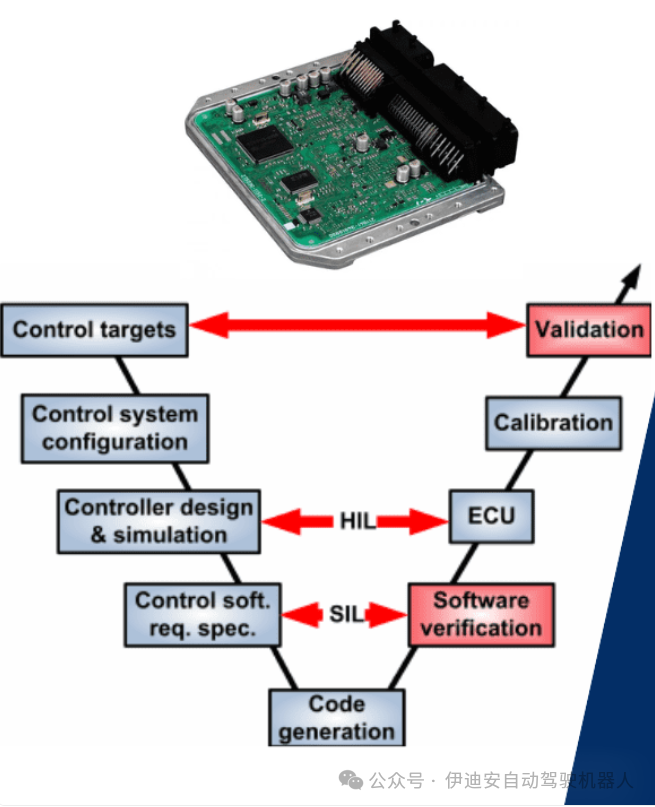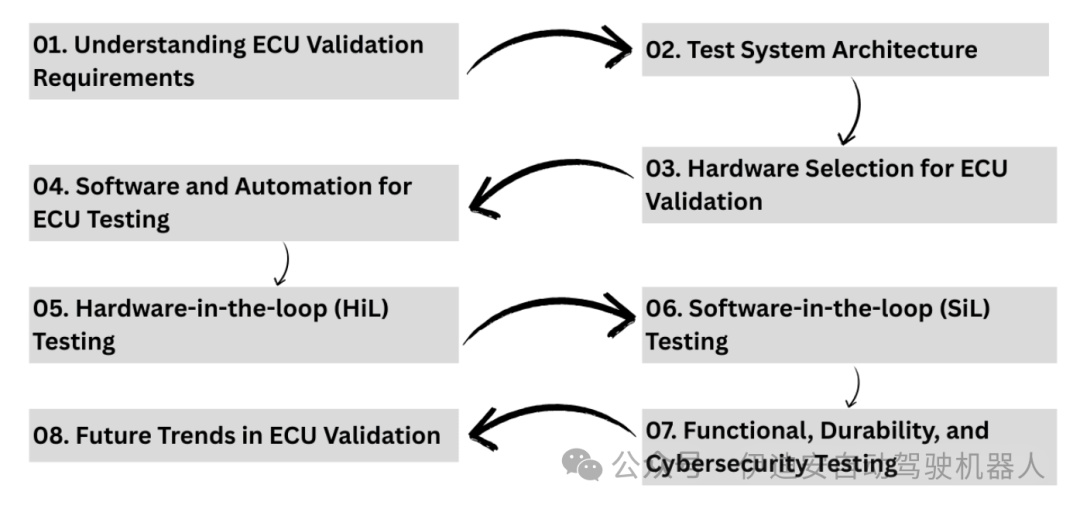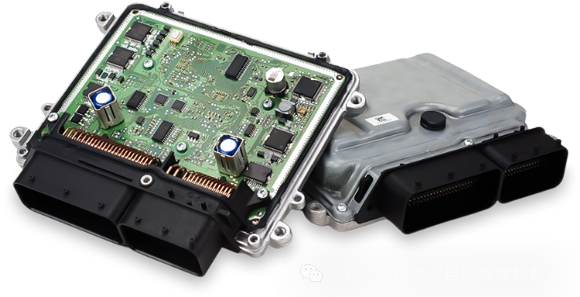
The Electronic Control Unit (ECU) is the backbone of modern automotive systems, responsible for coordinating critical functions such as engine performance, transmission control, safety features, and infotainment systems. As vehicles become increasingly interconnected and automated, the complexity of vehicles has risen, leading to an unprecedented demand for rigorous validation of ECUs.
ECU validation ensures that the unit meets functional, performance, and regulatory standards before deployment. Without proper testing, undetected faults in the ECU can lead to catastrophic failures, safety hazards, and costly recalls. This article explores the design and implementation of robust automotive testing systems for ECU validation. It delves into hardware and software selection, automation techniques, validation methods, industry standards, and best practices to ensure comprehensive and reliable ECU testing.

01. Understanding ECU Validation Requirements
1.1 Industry Standards and Regulations
Automotive ECUs must comply with various industry standards that define safety, reliability, and communication protocols. Some of the most widely recognized standards include:
-
ISO 26262: This functional safety standard outlines the lifecycle and safety requirements for automotive electrical and electronic systems. It mandates rigorous validation processes to minimize the risk of system failures.
-
ASPICE (Automotive SPICE): This framework assesses the maturity of software development processes in the automotive industry. It ensures consistent quality in ECU software development and testing.
-
AUTOSAR: This open standardized software architecture enhances the reusability and scalability of automotive ECUs.
-
SAE J1939 and ISO 14229 (UDS Protocol): These protocols define communication standards for vehicle networks, ensuring interoperability and diagnostic capabilities between different ECU modules.
1.2 Types of ECU Testing
ECU validation encompasses various types of testing, each focusing on different aspects of performance and reliability:
-
Functional Testing: Ensures that the ECU operates according to its intended functions under normal conditions.
-
Performance Testing: Evaluates response times, processing capabilities, and communication efficiency under various loads.
-
Durability Testing: Subject the ECU to prolonged operating cycles to assess its long-term reliability.
-
Cybersecurity Testing: Identifies vulnerabilities that could be exploited by attackers, ensuring robust protective measures are in place.
-
Regression Testing: Verifies that new software updates do not introduce unexpected issues in previously validated functionalities.
02. Testing System Architecture
The automotive testing system for ECU validation consists of multiple hardware and software components that work together to replicate real-world environments. Key components include:
2.1 Test Bench Setup
The test bench simulates the actual vehicle environment, providing a controlled setting for validating ECU functions. It typically includes:
-
Power Supply Unit: Provides stable voltage and current to the ECU.
-
Sensor and Actuator Simulators: Simulate real vehicle signals to interact with the ECU.
-
Environmental Chamber: Simulates extreme temperature, humidity, and vibration conditions.
2.2 Communication Interfaces
The ECU communicates with other vehicle components using various network protocols. The testing system must support:
-
Controller Area Network (CAN): The most widely used communication protocol in automotive ECUs.
-
Local Interconnect Network (LIN): An economical protocol for non-critical applications.
-
FlexRay: A high-speed network for Advanced Driver Assistance Systems (ADAS).
-
Ethernet: Supports high-speed data transmission for modern connected vehicles.
2.3 Data Acquisition System
A robust data acquisition system is crucial for real-time monitoring, recording, and analyzing ECU performance metrics. Key components include:
-
High-Speed Data Recorders: Capture ECU communications and sensor data.
-
Signal Conditioning Modules: Ensure accurate readings from sensors and actuators.
-
Real-Time Monitoring Software: Visualizes and analyzes test results.

03. Hardware Selection for ECU Validation
Selecting the appropriate hardware for ECU validation is critical to ensuring the accuracy and reliability of test results. Key components include:
3.1 Microcontrollers and Processors
The testing system should match the processing capabilities and architecture of the ECU being validated. Factors to consider include:
-
Clock Speed and Processing Power
-
Memory Requirements
-
Compatibility with Automotive Operating Systems
3.2 Signal Conditioning Modules
As the ECU interacts with various sensors and actuators, signal conditioning modules help convert raw signals into usable data. These modules include:
-
Analog-to-Digital Converters (ADC)
-
Digital-to-Analog Converters (DAC)
-
Filters and Amplifiers
3.3 Automotive Communication Tools
Dedicated tools are required to connect to the ECU communication network. Common tools include:
-
Vector CANoe: Used for the development, simulation, and testing of CAN and LIN networks.
-
dSPACE: Provides real-time simulation and validation tools.
-
NI PXI: Offers modular instruments for automated testing.
3.4 Load Simulators and Actuators
To ensure the ECU operates correctly under different working conditions, the testing system must include:
-
Variable loads to replicate real electrical and mechanical stresses.
-
Actuators to simulate mechanical movements controlled by the ECU.
-
Dynamic test benches to simulate road conditions.
04. Software and Automation for ECU Testing
Automation plays a crucial role in reducing human intervention, increasing accuracy, and accelerating the ECU validation process. Key software solutions include:
4.1 Model-Based Testing
Using MATLAB Simulink, engineers can create virtual models of the ECU and test them under various conditions before deploying them to hardware.
4.2 Automated Test Scripts
Programming languages such as Python, CAPL, and LabVIEW are used to automate testing, data collection, and analysis.
4.3 Test Management Tools
Managing ECU test cases and results requires dedicated tools, such as:
-
IBM DOORS: For requirements tracking.
-
JIRA: For issue tracking and test case management.
-
Jenkins/GitLab CI/CD: For continuous integration and automated testing.
05. Hardware-in-the-Loop (HiL) Testing
HiL testing integrates real ECUs with simulated vehicle environments, allowing engineers to:
-
Test real-time performance and response times.
-
Inject faults to assess the ECU’s error handling capabilities.
-
Simulate different driving conditions without a physical vehicle.
06. Software-in-the-Loop (SiL) Testing
SiL testing is a cost-effective method for validating ECU software before deploying it to actual hardware. It helps to:
-
Identify software bugs early.
-
Quickly simulate thousands of test scenarios.
-
Reduce reliance on hardware prototypes.
07. Functional, Durability, and Cybersecurity Testing
To ensure the ECU operates reliably under all conditions, additional testing is required:
-
Temperature and Vibration Testing: Simulates extreme conditions.
-
Pentration Testing: Identifies potential security vulnerabilities.
-
Electromagnetic Interference (EMI) Testing: Ensures compliance with automotive regulations.
08. Future Trends in ECU Validation
The future of ECU validation will be driven by emerging technologies:
-
Artificial Intelligence (AI) for predictive analytics.
-
Cloud-based scalability testing.
-
Digital twins for real-time simulation.
Conclusion
Designing automotive testing systems for ECU validation requires a systematic approach that integrates hardware, software, automation, and safety measures. By implementing best practices and leveraging modern technologies, engineers can ensure the reliability and safety of automotive ECUs, paving the way for the future of smart connected vehicles.